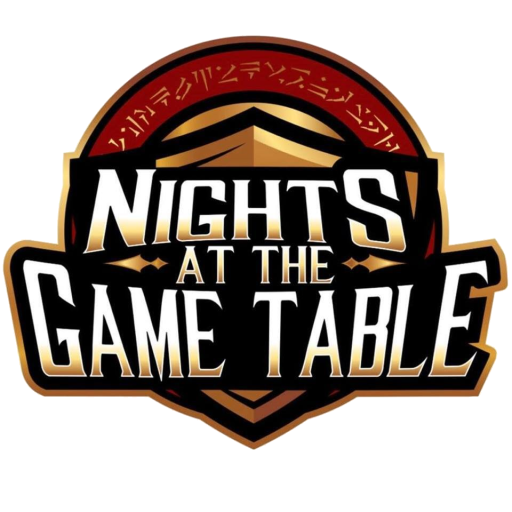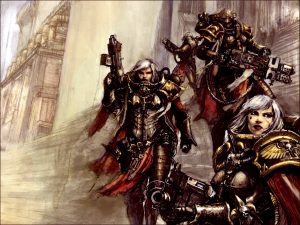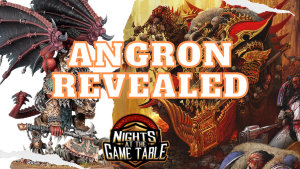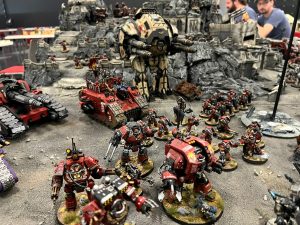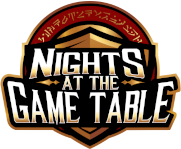Last time we looked at the Charge Phase and how we can use our charge movement to achieve objectives other than just engaging in combat, as well as how to tilt combats in our favor. To build on that, this time we are going to look at the Fight Phase, and in particular, the two movements we make with each unit in the fight phase.

First, let’s go over the steps of the phase:
- Choose unit to fight with
- Pile in
- Choose targets
- Choose melee weapon
- Resolve attacks
- Consolidate
Starting at the beginning, choosing a unit to fight with, can be very important when there are multiple combats and multiple units engaged in combat. Specifically, our choices matter when our opponent can interrupt our chargers and/or not all of our engaged units charged this turn. Sometimes this is obvious; our opponent has a very deadly combat unit engaged with our deadly combat unit so we want to make sure we swing first. In other occasions it can be more subtle. For example, let us look at the first example from last week, where we were trying to claim an objective from our opponent.

After our charge, we were in position to pile in to the Tactical squad and loop around the Razorback to get all four of our models within range of the objective. However, if there was another combat we resolved first, a wily opponent could interrupt with the Razorback to foil our plans. By activating first, the Razorback can then be moved through its Pile In and Consolidation to “base” two or three members of the squad, stopping us from moving further:
This brings us to the first of the two moves in the fight phase, the Pile In. Pile in and Consolidation have the exact same restrictions, they are just done at different times. Both allow for the following movement:
You may move each model in the unit up to 3” – this move can be in any direction so long as the model ends the move closer to the nearest enemy model.
The permissions and restrictions in this movement are very important, so apologies but I’m going to be a little pedantic here in breaking this down. The only requirement on this move (outside of the always in place restrictions of maintaining coherency in a unit) is that a model must end closer to the closest model it began the move to. It does not have to end the move with the closest model after the move being the same model that was closest to begin the move.
In the interrupt example above, the Razorback began with the lowest Chaos Space Marine just within 1”. After a 3” move, the Razorback must end with that model closer, say 0.75” away, but can then be 0.5” from the Aspiring Champion at the top of the line. Then, after the Razorback attacks, likely doing nothing, the vehicle consolidates, “basing” the top and bottom models in the unit.
A quick note on “basing” as it is an important concept in the fight phase. Because of the restriction on Pile In and Consolidation movements that they must end closer to the closest, by going base-to-base with another model, “basing”, both models are then locked in place for any further combat moves until one is removed as a casualty or one unit falls back from combat.
Finishing out the example above, by basing the top and bottom models in the unit, the Razorback has totally stopped us from achieving our goal since those two models cannot move, and the other two models cannot break coherency to loop around much at all.
Now, let’s look at this example if we had gone first with the charging Black Legion unit and achieved our goals. After Pile In, the positioning looks like this:

The Aspiring Champion has gotten within an inch of the Tactical Marines and the rest of the unit has begun looping around the Razorback. The next steps in combat are choosing targets, weapons, and resolving attacks. The Champion and closest Legionary are attacking the Tactical Marines, while the other two attack the Razorback. The Aspiring Champion uses his power fist and kills one marine, with no other wounds dealt. The unit can then consolidate and take the objective:

In attacks back, there are decent odds we don’t suffer any unsaved wounds and thus, take the objective to end the game.
The second example from last week was a little more straightforward as we were mainly looking at avoiding Heroic Intervention and minimizing the return attacks our unit would take by charging toward just one end of the enemy unit, like so:

After our Pile In, we can get every member of our unit in range to attack:

After fighting, our unit kills two Tactical Marines, forcing some choices on our opponent on which models to remove. In order to maximize their attacks back, they would need to remove the top two models, which includes the Sergeant. Assuming they don’t want to do that, the next best move is to kill off the second and fourth models from the top, as the unit would then still be able to pile in and attack, though likely with only one model. However, leaving that lowest model also gives us the opportunity to take it as a “hostage” by surrounding its base and preventing it from falling back, locking the unit in combat like so:

Since the Ultramarines’ attacks are not likely to do much, their best option is actually to just pull the bottom two models; they will not be eligible to activate at all since they will no longer be within an inch of an enemy, but they also are free to act in their following turn, leaving the units like this:

In the third example from last week, we were looking to engage a Leman Russ Executioner to prevent it from firing in the following turn. However, we were just outside of 12” and so, unable to declare it as a charge target. We instead charged a closer Infantry unit and used that movement to get us to this position, where our model closest to the tank is closer to that than the Infantry unit:

Being able to get those two outside models closer to the tank was very important as it allows them to move toward the tank legally with their Pile In and Consolidation. After the Pile In, the unit can get to this position:

The two models on the right moved straight down toward the tank 3”. The two models on the left looped a little to create a line between them and the tank. Finally, the middle model, who began about 6” to the closest model (an infantryman) moved to be just slightly closer to that model while angling toward the tank and be in position to maintain coherency across the two sides of the unit.
After fighting and killing just a single Guardsman, we can then pile in, like so:

We could move the Aspiring Champion to just re-engage the guardsmen, but with their orders to be able to still fire, it is probably not worth taking their return attacks. We will be unable to trap either of the enemy units in combat, however, we did accomplish our goal of stopping the Leman Russ from firing at the rest of our army next turn.
As our last example on how to use the rules for Pile In and Consololidation moves to our advantage, let us take the below scenario, as the Blood Angels player:

In the previous turn, the Tyranid player cast Paroxysm on our Death Company, meaning they will have to fight last. Normally, if they just charged into the Genestealers and didn’t go first, they would likely get slaughtered before getting to swing. Knowing this and applying what we know about the Charge Phase and the Fight Phase movements, we moved a couple Rhinos to support and moved the Death Company to get a flanking charge (like our second scenario, above) on the Genestealers.
We moved the Rhinos in this way knowing that any Genestealers closer to the Rhinos will not be able to pile in toward the Death Company. We don’t even need to charge with the Rhinos – they are in good position there. After our charge of an average 7” with our Death Company, we put ourselves in the below position:

The red line shows the divide between models in the Genestealer unit that are closer to the Rhino versus those closer to the Death Company. As a result, only those five models can move closer to the Death Company, and they must maintain coherency with the models that cannot move away from the Rhino. The result is, after Piling In, the Genestealers can only get four models in range to attack the Death Company, with another four attacking the Rhino in the middle:

After swinging, they still manage to kill off five of our Death Company, leaving us 10 to fight back with, much better than if we had engaged directly. Our opponent chooses not to Consolidate closer, knowing it would make it easier on us, but we are still able to get all 10 of our Death Company in range to attack:

With 40 attacks, we are able to kill off 12 of the enemy Genestealers, just about neutralizing this very scary combat unit for the cost of a few of our Death Company (and probably some wounds on a Rhino).
As we can see, there is a lot of nuance to the Charge and Fight Phases, particularly in how we move to gain an advantage. Knowing how to use these movements can win you games, without a doubt, and we have only touched on a few of the infinite scenarios that can occur during a game.
